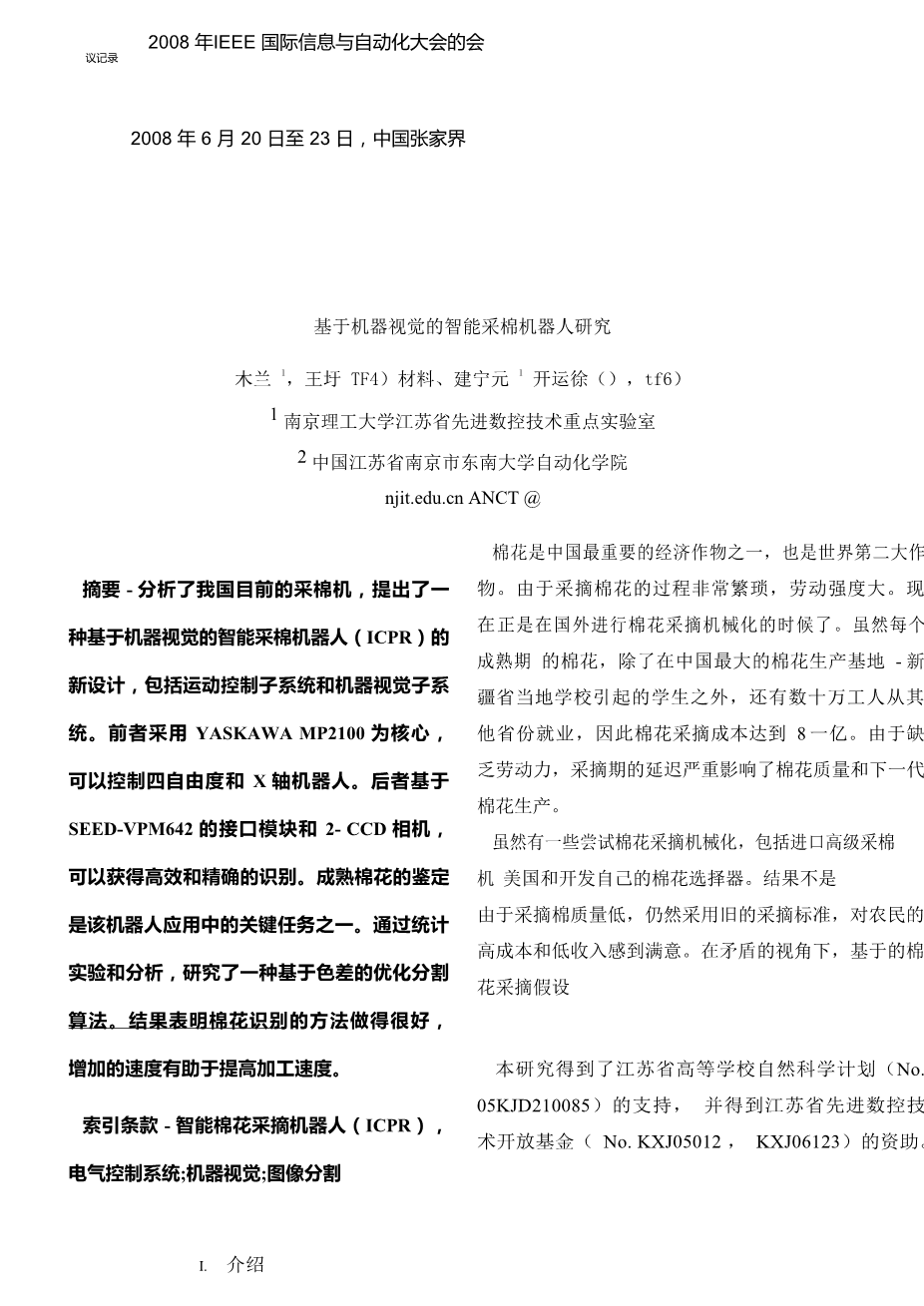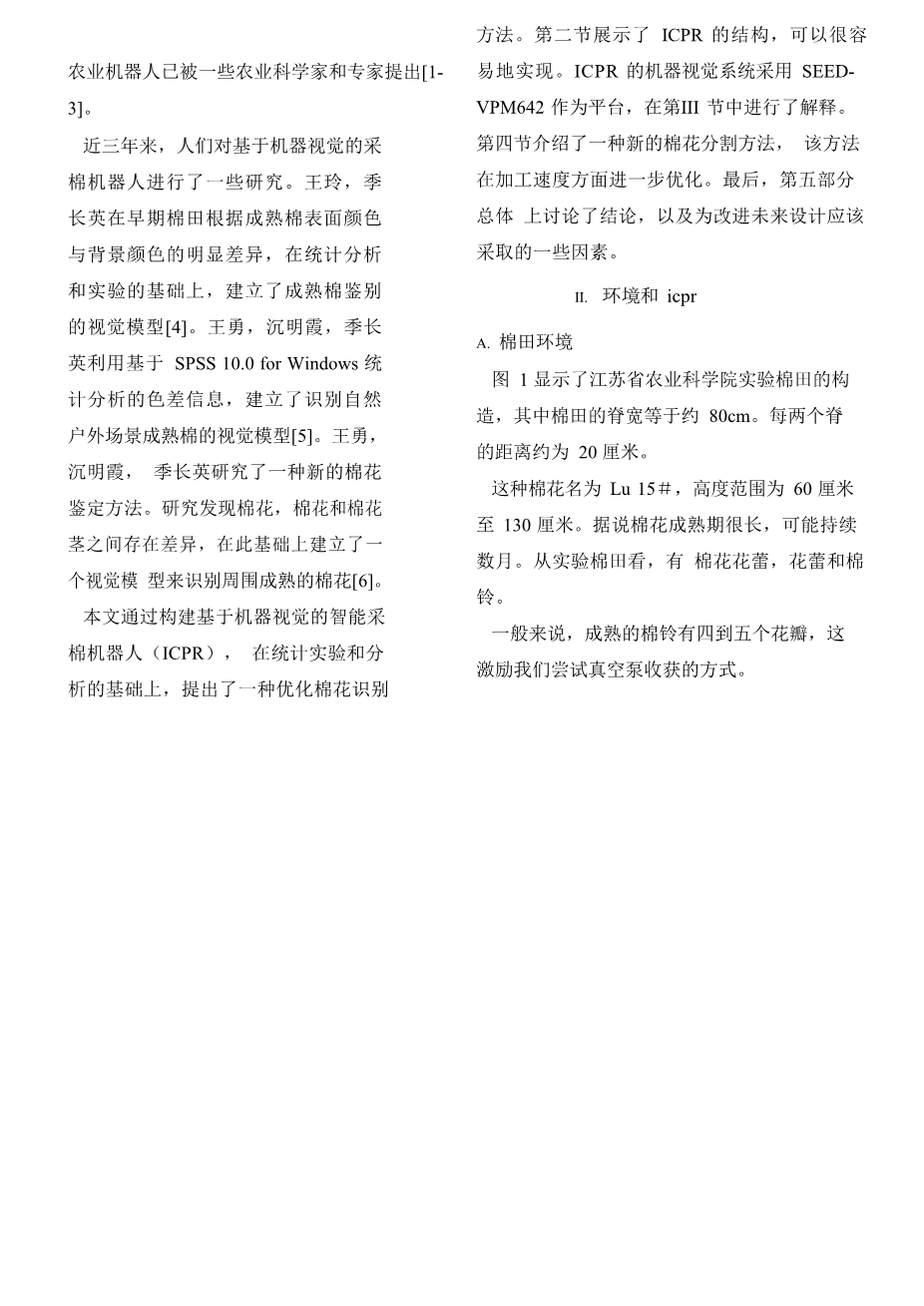Proceedings of the 2008 IEEE International Conference on Information and Automation
June 20 -23, 2008, Zhangjiajie, China
A Research for Intelligent Cotton Picking Robot Based on Machine Vision
Mulan Wang1, Jieding Wei2, Jianning Yuan1, Kaiyun Xu1
1Jiangsu Key Laboratory of Advanced Numerical Control Technology, Nanjing Institute of Technology
2School of Automation, Southeast University Nanjing, Jiangsu Province, China anct@njit.edu.cn
Abstract – Analysing the cotton picker in current situation of China, this paper proposed a new design of Intelligent Cotton Picking Robot (ICPR) based on machine vision including the motion control subsystem and machine vision subsystem. The former adopts the YASKAWA MP2100 as the core, which can control the robot of 4-DOF and X-axis. The latter based on the interface module of SEED-VPM642 with 2-CCD cameras, can get an efficient and precise recognition. The identification of mature cotton is one of the critical tasks in this robotic application. According to the statistic experiments and analysis, an optimized segmentation algorithm based on chromatic aberration is studied. The results demonstrate that the method for cotton recognition is well done and the increased pace helps improve the speed of the processing.
Index Terms– Intelligent Cotton Picking Robot (ICPR), electrical control system; machine vision; image segmentation
- INTRODUCTION
Cotton is one of the most important economic crops in China and also the second biggest crop production of the world. Since there is so much boring procedure and heavy intensity of labor with cotton picking. It is high time to make the mechanization of cotton picking abroad. While every mature period of cotton, there are hundreds of thousand workers employed from other provinces besides the students who are aroused by local schools in the Xinjiang Province which is the biggest cotton production base in China, so that the cost of cotton picking amount to eight hundred millions. The delay in picking period critically influences both the quality of cotton and the next generation of cotton production due to lacking labor.
Although there are some trying in mechanization of cotton picking, including importing advanced cotton picker of the
U.S.A and developing own cotton picker. The result is not satisfied for the high cost and the low income of the farmers due to the low quality-level of picked cotton, which still adopts the old standards for hand picking. In the view of the contradiction, an assumption for cotton harvesting based on
This research is supported by natural science plan of Jiangsu higher education institutions of China (No. 05KJD210085) and sponsored by advanced numerical control technology open foundation of Jiangsu province (No. KXJ05012, KXJ06123).
agricultural robot has been proposed by some agricultural scientists and specialists [1-3].
Some researches on cotton picking robot based on machine vision had been done in last three years. WANG Ling, JI Chang-ying established the visual model of discrimination of mature cotton according to the obvious difference between the surface color of mature cotton and background color in early cotton field, on the basis of the statistic analysis and experiments [4]. WANG Yong, SHEN Ming-xia, JI Chang- ying established the visual model that recognize the mature cotton in natural outdoor scenes by using the chromatic aberration information based on the statistical analysis with SPSS 10.0 for Windows [5]. WANG Yong, SHEN Ming-xia, JI Chang-ying studied a new method of cotton identification. The study found that there exist differences between cotton, cotton leaf and cotton stem, based on which a vision model was set up to identify ripe cotton from surroundings [6].
In this paper, by structuring Intelligent Cotton Picking Robot (ICPR) based on machine vision, an optimized method to identify cottons is proposed on the basis of statistic experiments and analysis. Section II shows the construction of ICPR, which can be easily realized. The machine vision system of ICPR adopted the SEED-VPM642 as the platform is explained on Section III. Section IV introduces a new method for cotton segmentation, which is further optimized in the processing speed. Finally, Section V examines the conclusion in general and some factor that should be done to improve the design in the future.
- ENVIRONMENT AND ICPR
- Cotton Field Environment
Fig. 1 shows the configuration of experimental cotton field in Jiangsu Academy of Agricultural Sciences, where the width of ridge in the cotton field is equal —about 80cm. And the distance of every two ridges is about 20cm.
This type cotton is named Lu 15#, whose height can range from 60cm to 130cm. And it is said that the cotton mature period is very long, which can span several months. As seen from the experimental cotton field, there are cotton flowers, buds and also cotton bolls.
In general, the mature cotton boll has four or five petals, which inspires us to try the way of vacuum pump harvest.
978-1-4244-2184-8/08/$25.00 © 2008 IEEE. 800
Industrial Computer
80cm
20cm
Fig. 1 Configuration of experimental cotton field
- Construction of ICPR
Without considering the interact on track, manipulator and X-axis, the ICPR is designed to 900mm width and 1500mm height, supposed travel at a constant low speed.
In order to realize the automatic traveling and the power driving, the base plate is designed. Considering the soft and rugged field, the track is adopted. Referring other agricultural robot’s construction, the ICPR’s hand is made up of a 4-DOF manipulator and a X-axis. As the simplicity and feasibility, the scheme of two cameras vision is used. YASKAWA servo sys
剩余内容已隐藏,支付完成后下载完整资料


英语译文共 11 页,剩余内容已隐藏,支付完成后下载完整资料
资料编号:[443216],资料为PDF文档或Word文档,PDF文档可免费转换为Word


